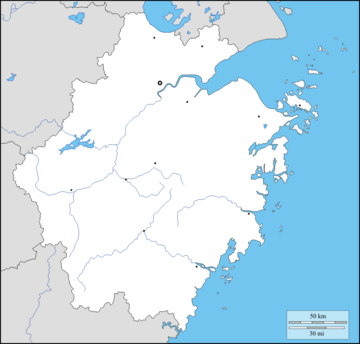Anji County
| Anji County 安吉县 | |
|---|---|
|
| |
 Anji Location of the seat in Zhejiang | |
| Coordinates: 30°37′48″N 119°40′17″E / 30.63000°N 119.67139°ECoordinates: 30°37′48″N 119°40′17″E / 30.63000°N 119.67139°E | |
| Country | People's Republic of China |
| Province | Zhejiang |
| Prefecture-level city | Huzhou |
| Origins | 200 AD |
| Seat | Changshuo Subdistrict |
| Government | |
| • County Magistrate | Shen Mingquan |
| Area | |
| • Total | 1,886 km2 (728.19 sq mi) |
| Elevation | 20 to 1,600 m (65 to 5,250 ft) |
| Population (2013) | 461,800 |
| • Density | 244.9/km2 (634.2/sq mi) |
| Time zone | UTC+8 (China Standard Time (CST)) |
| Postal code | 313300 to 313310 |
| Area code(s) | 0572 |
| Website |
www |
![]()
Anji is 65 kilometers from Hangzhou. During the 1990s, it took more than two hours to travel to Hangzhou by bus. Poor transportation isolated Anji from the rest of Zhejiang Province, and for many years its economy remained underdeveloped. From 1997 to 2000, highways were built to Hangzhou and Huzhou, and from 2000 to 2002, highways connecting to National Highway G318 were constructed. The provincial highways within its boundary were also widened. Now the highway system traversing the entire boundary has been completed, and it takes less than three hours to reach Shanghai, Nanjing or Suzhou, and less than one hour to get to Hangzhou and Huzhou. Some of Anji's residents have attempted to take the sustainable development road by developing ecology-friendly agriculture, industry and tourism, and building an ecology-friendly city.
Tianhuangping Pumped Storage Power Station is located there.
Administrative Division of Anji County

There are 15 towns or subdistricts in Anji.These below are:
| No. | Towns or Subdistricts | Chinese name | No. | Towns or Subdistricts | Chinese name |
|---|---|---|---|---|---|
| 1 | Dipu Subdistrict | 递铺街道 | 9 | Xiaofeng Township | 孝丰镇 |
| 2 | ★Changshuo Subdistrict | 昌硕街道 | 10 | Hanggai Township | 杭垓镇 |
| 3 | Lingfeng Subdistrict | 灵峰街道 | 11 | Zhangcun Township | 章村镇 |
| 4 | Xiaoyuan Subdistrict | 孝源街道 | 12 | Baofu Township | 报福镇 |
| 5 | Tianzihu Township | 天子湖镇 | 13 | Shangshu Township | 上墅乡 |
| 6 | Meixi Township | 梅溪镇 | 14 | Tianhuangping Township | 天荒坪镇 |
| 7 | Xilong Township | 溪龙乡 | 15 | Shanchuan Township | 山川乡 |
| 8 | Zhangwu Township | 鄣吴镇 |
★ Where Anji county government located
Ecological Tour
The ecological tour area covers one-tenth of the county's total area. Anji produces 12 million commercial bamboo poles annually, ranking first nationwide. It also has China's largest bamboo nursery. The Anji Bamboo Garden is acknowledged by scholars within and outside China as containing the widest variety of bamboo to be found. It was formerly a bamboo grove research base that combined scientific research with teaching, and has received many foreign experts and scholars and officials from the International Network for Bamboo and Rattan.
At the Longwang (Dragon King) Mountain Nature Reserve, lies the source of the Huangpu River, and the 800-hectare primeval forest there contains numerous flora and fauna under national protection; Amji's Salamander is only known from this reserve.[2] The Huadong Pumping Storage Power Station, located in the Tianhuangping Scenic Area, is the largest in Asia and second largest worldwide. It is meant to blend in with the surrounding environment, and is a Chinese industrial demonstration project. In 2001, Anji received 1.4 million tourists, earning it 310 million yuan, which made up 6.1% of the county's GDP. A feasibility plan recently commenced on the 20 km2 (7.7 sq mi) British designed Huxi Ecological Garden. Qian Kunfang, county magistrate, says, "Though ours is a mountainous county, we nevertheless receive large numbers of visitors, either sightseeing or seeking to invest, every day. Anji's mountains, waters and pure air are now valuable commodities."
Ecology-Friendly Industries
When developing ecological tourism, the local people naturally gravitate towards ecology-friendly agriculture and industry. By taking advantage of their favorable environment and climate, they are able to develop pollution-free green products, such as bamboo shoots, white tea, alpine vegetables, and flowers. Production bases for green products have been opened, and specialized markets for agricultural products and comprehensive wholesale markets built. In order further to supplement ecological tourism, agricultural sightseeing gardens that provide leisure activities have also been constructed. Pollution-free products currently make up 40 percent of the market, and the per capita income of farmers has increased steadily, from 3,708 yuan in 1998 to 4,556 yuan in 2001. Anji white tea, grown nowhere else in the country, sells for a price higher than the famous Dragon Well tea. Chain production is a characteristic of Anji's industry. Bamboo, for instance, can be made into food, handicrafts, and building materials, and its remnants can also be utilized. Anji products are now exported to more than 20 countries and regions, and about one-fourth of the county's gross output value of agriculture and industry comes from bamboo-related industries. Anji's fine ecological environment has attracted large numbers of investors. In 2001 alone, over US $50 million in foreign investment was absorbed. But the local government is strict about protecting its environment, and no future projects are permitted that incur the slightest possibility of pollution.
References
- ↑ "安吉县人民政府 2013年安吉县国民经济和社会发展统计公报". www.anji.gov.cn.
- ↑ Gu, H. & Lau, M.W.N. (2004). "Hynobius amjiensis". IUCN Red List of Threatened Species. Version 2012.2. International Union for Conservation of Nature. Retrieved 11 November 2012.
External links
| Wikivoyage has a travel guide for Anji. |